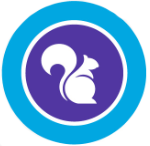Third Grade
The four third grade units introduce students to sophisticated scientific practices like scientific modeling, planning and carrying out investigations with fair tests, field work, and engineering. Students begin to consider the importance of evidence when describing how squirrels survive, considering how toys move, planning the design of a bird feeder, and arguing for one kind of seed over another for planting in the shade. Third grade units emphasize ideas in ecology, traits and weather, as well as balanced and unbalanced forces using the crosscutting concepts systems & system models and structure & function.
 Unit 3.1 Squirrels
Unit 3.1 Squirrels
Students observe squirrels in their community and plan and conduct investigations to develop models to explain how the squirrels interact with other organisms in their environment. Students explore the driving question: Why do I see so many squirrels, but I can find any stegosauruses? For the final artifact, students create a model to explain that as the environment changed, some animals (mammals) were able to adapt and others (dinosaurs) died out. They expand on the model through writing or performance.
Miller, E., Codere, S., Severson, A., Fitzgerald, M., Modaff, M., Palincsar, A., Krajcik, J.
 Unit 3.2 Toys
Unit 3.2 Toys
Students make prototypes of moving toys and then observe and develop models to describe the pattern of motion to explore the question How can we design fun moving toys that other kids can build? For the final artifact, students revise their models and develop engineering solutions, then produce a design portfolio to show how they have incorporated what they have learned.
Peek-Brown, D., Finnie, K., Fitzgerald, M., Palincsar, A., Miller, E., Codere S., Krajcik, J.
 Unit 3.3 Birds
Unit 3.3 Birds
Students conduct fieldwork to gather information about the birds that live near the school. They make claims that the birds' physical and behavioral traits are adapted to the habitat they live in to explore the question How can we help the birds around our school grow up and thrive? For the final artifact, students design bird feeders that take into account the physical and behavioral traits, the effects of changing weather, the features of the environment, and the needs for reproduction of the focal bird.
Miller, E., Severson, A., Codere S., Fitzgerald, M., Modaff, M., Easley, K., Palincsar, A., Krajcik, J.
 Unit 3.4 Plants
Unit 3.4 Plants
Students ask questions, make observations, investigate, and model how plants' traits affect their survival to explore the question How can we plan gardens for our community to grow plants for food? The final artifact includes planning a garden and designing, testing, and making claims about the merits of a solution (tool or process) to protect the garden plants from weather-related hazards or changes in the environment.
Peek-Brown, D., Fitzgerald, M., Palincsar, A., Miller, E., Codere S., Krajcik, J.


